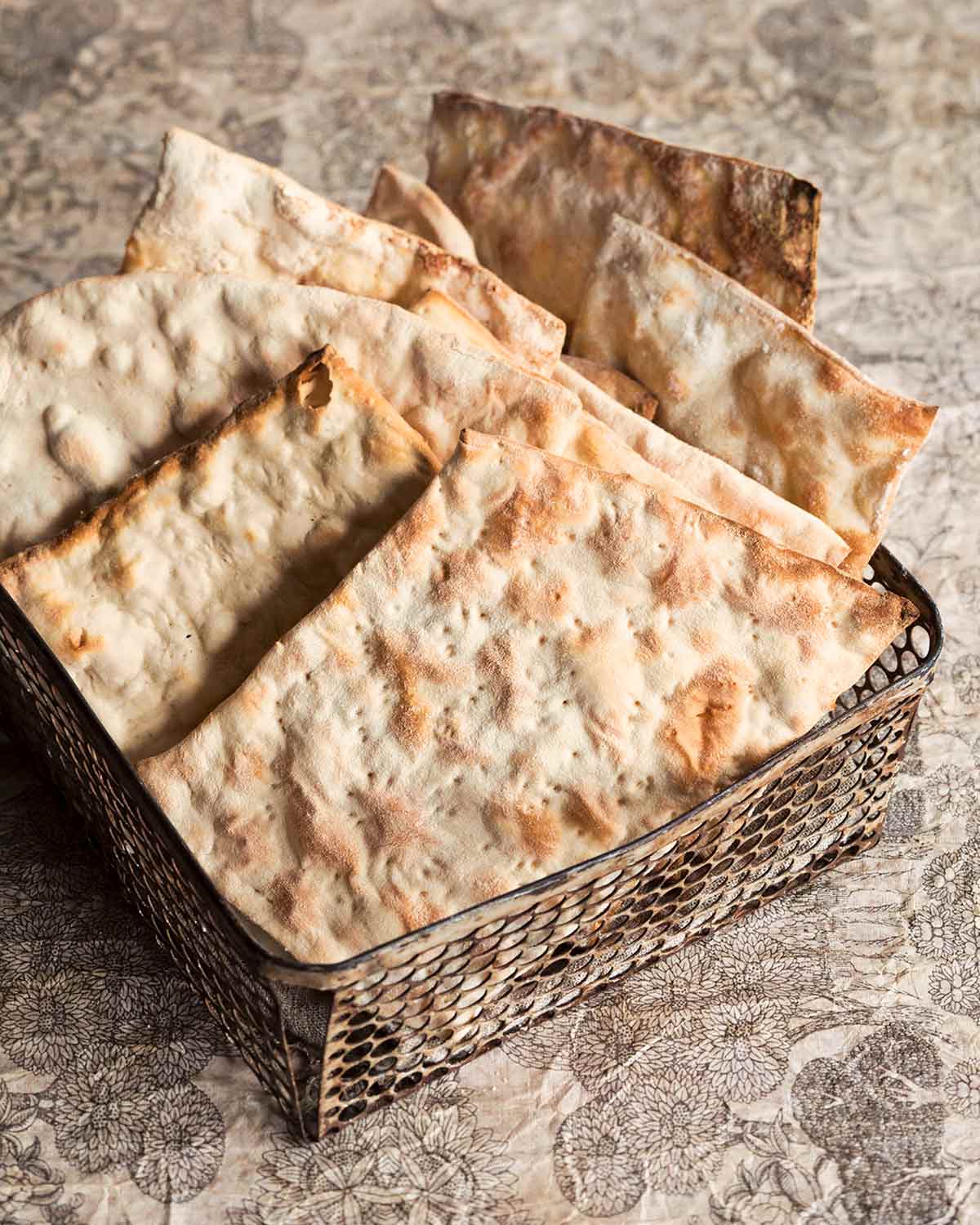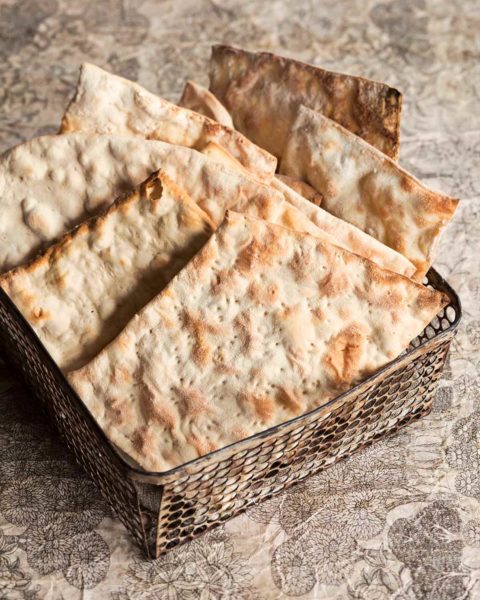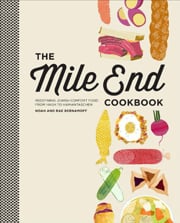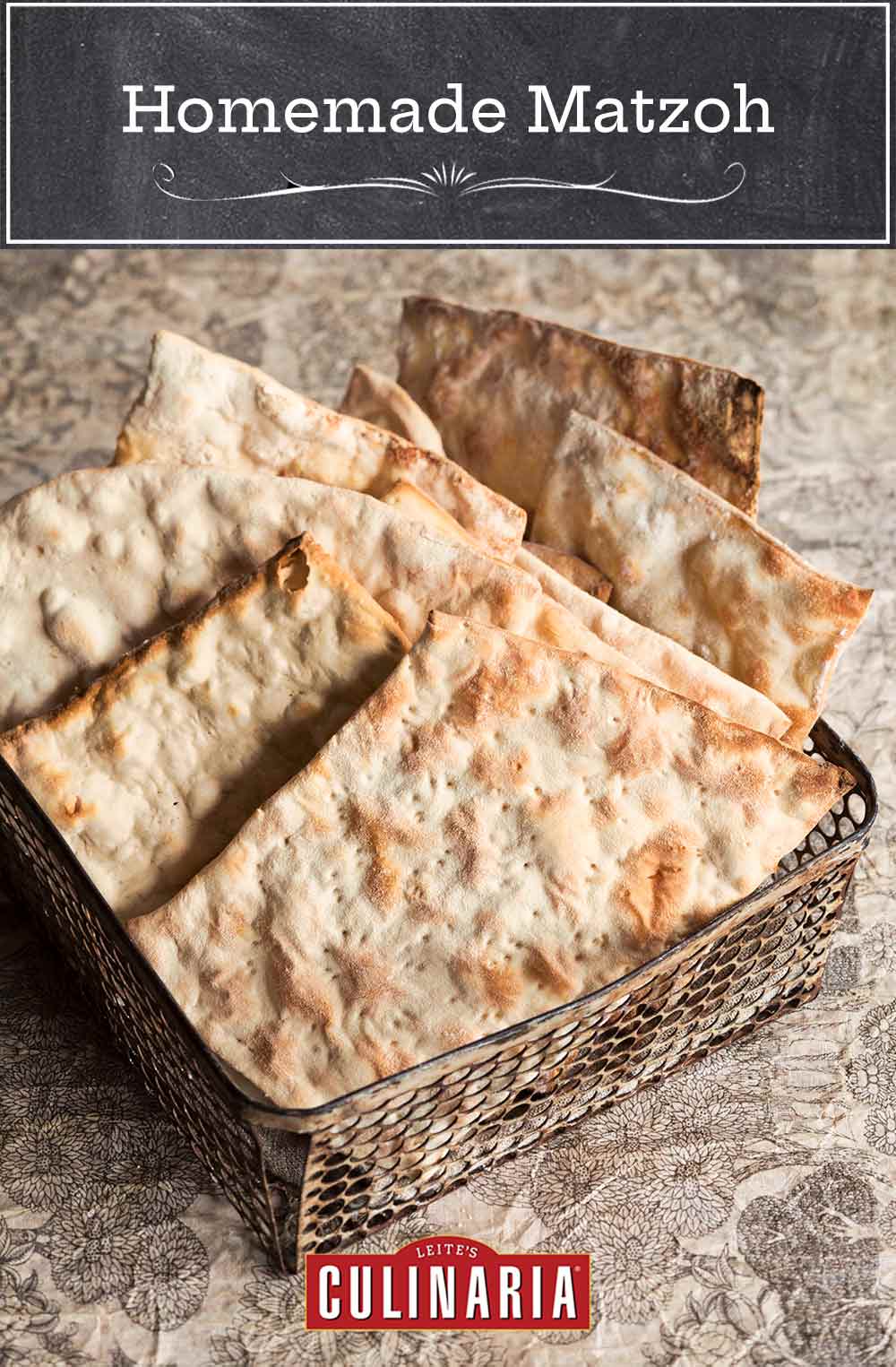
Homemade matzoh? It’s actually quite easy to make. A pasta roller helps tremendously in terms of both ease and time. As for what to schmear on that homemade matzoh, we can help with that, too. Just click your heels three times and then check out our Matzohpaloozah. –David Leite
Homemade Matzoh FAQs
No, neither in the historical nor religious definition of the term. Matzoh has only ever contained two ingredients: flour and water. The authors of this recipe, which comes from the Mile End Cookbook, added salt for flavor and oil for ease of rolling for home cooks. Perhaps it’s better to think of them as matzoh-style crackers. But even the word “crackers” isn’t exactly correct because crackers contain leavening agents, either baking soda or yeast.
So this is a kind of hybrid. Not sparse enough to be matzoh, not robust enough to be crackers. Perhaps look upon these as an ecumenical food….
In order for matzoh to be technically unleavened and appropriate for Passover, according to Jewish tradition, it must be started and completed within 18 minutes. This is because fermentation is believed to happen after 18 minutes of ground grain being in contact with water, and Jewish law requires only unleavened foods be eaten during the duration of Passover.
Matzoh can be pretty bland on its own, but the options for serving it are endless. If you’re not strictly observant to Passover law, go ahead and schmear with cream cheese or sour cream and top with smoked salmon, dollop on hummus, or serve as you would your favorite cracker. Alternatively, you could grind up the homemade matzoh to make matzoh meal for matzoh ball soup or Passover brownies.

Homemade Matzoh
Equipment
- Pasta machine (optional)
Ingredients
- 4 1/2 cups sifted all-purpose flour, plus more for rolling
- 1 teaspoon Diamond Crystal kosher salt, plus more for sprinkling
- 2 tablespoons mild olive oil
- 3/4 cup plus up to 1/2 cup warm water
Instructions
- Preheat the oven to 500°F (260°C). Ideally you would place a pizza stone on the bottom oven rack, but realistically a 10-by-15-inch baking sheet will work just dandy.
- In a large bowl, mix together all the ingredients, starting with just 3/4 cup water, until everything comes together to form a dough. If the dough seems dry, add a little more water, just a few drops at a time. Be sparing with the water and do not add so much that the dough becomes sticky.
- Let the dough rest for 10 to 15 minutes.
- Divide the dough into 8 pieces. Flatten a piece slightly and pass it repeatedly through a pasta maker, reducing the thickness each time until you eventually reach the thinnest or minimum setting on your pasta machine. Alternately, you can simply roll the dough as thinly as possible with a rolling pin on a lightly floured surface. Repeat with the remaining dough pieces.
- Trim the rolled-out dough pieces into rectangles. (How many pieces of matzoh you get depends on how thinly you rolled the dough.) Use a fork to prick holes in the surface of the dough. lf salted matzoh are desired, brush or spray the dough surface lightly with water and sprinkle with salt to taste.
- Carefully place some of the rectangles onto the pizza stone or baking sheet. They should fit snugly but should not touch. Bake until the surface of the matzoh is golden brown and bubbly, 30 to 90 seconds.
- Using tongs, carefully flip the matzoh pieces and continue to bake until the other side is golden browned and lightly blistered, 15 to 30 seconds. Keep careful and constant watch to keep the matzoh from burning; the exact baking time will vary from oven to oven and will get longer with subsequent batches. You want to let the matzoh get a few dots of light brown but don’t let the matzoh turn completely brown or it will taste burnt.
- Let the matzoh cool before serving. (When our testers made this, they devoured it within hours—and sometimes minutes—of pulling it from the oven, but typically with this sort of baked good you can keep it in an airtight container or resealable plastic bag at room temperature for up to a couple days.)

Nutrition
Nutrition information is automatically calculated, so should only be used as an approximation.
Recipe Testers’ Reviews
Making these homemade matzoh crackers left me with the same sense of wonder I had the first time I made pasta. The dough was a snap to put together with only 4 ingredients. I rolled it out by hand, and the resulting crackers reminded me of cream crackers—they were creamy and complete with golden blisters. They were also devoured within minutes of exiting the oven, gladly embraced by peanut butter and Nutella!
The homemade matzoh isn’t only fun to make, it tastes just like store-bought but fresher. And it’s more authentic-looking.
Although it was difficult to get the dough to the right consistency for rolling out, once I did, the results were wonderful. My dough was way too dry with 3/4 cup plus 1 tablespoon water. l kept adding water (approximately another 1/4 to 1/2 cup) until the dough came together. It didn’t feel right, so I made another batch, thinking I added too much flour to the first batch. Same thing happened. So I went back to the first batch (about 10 to 15 minutes later), and voilà, the dough felt perfect for rolling out. I rolled the dough out in the pasta maker. This amount was easy to handle and made for a good-size piece of matzoh. I baked it on a hot pizza stone, and it took 1 1/2 minutes on the first side and a quick 15 seconds on the second side at 500°F. Be sure not to let the matzoh get golden brown, as it starts to taste burnt.
Just let the matzoh get a few dots of light brown and you’re good to go. Think of the possibilities: flavoring the dough with different spices, cutting it into fun shapes, etc. I can’t wait for Passover!
Simple ingredients, some mixing and rolling, and I made delicious homemade matzoh. Well, maybe more like delicious homemade crackers. Mixing is easy, but rolling and trimming take some time. A quick bake in the oven resulted in a delicious cracker that somewhat resembled matzoh.
I used my pasta machine to roll the dough and felt that it was best at the second-to-last setting on the roller. Using my pasta maker resulted in sheets of dough that were about 36 inches by 5 inches when rolled at the thinnest setting. (And then there were 7 more to go.) Frankly there was so much dough I actually threw out the last ball because I was tired of making them. I was able to make my fork marks, cut the dough into rectangles, and transfer the sheets easily to a preheated baking sheet. I imagine that rolling by hand would yield a very different product. Using the pasta machine makes them fun to make and a consistent thickness. I could imagine these with butter, cheeses, tuna salad, or as a nice addition to a bread basket. I might even consider using them for Passover.
I think that next time I’d salt some of them. My preference was for the ones that I made a bit on the thicker side. Watch the oven carefully, as the brown blisters can cross over into burnt in minutes.
I must admit that I don’t care much for matzoh but with Passover not too far off I thought it’d be fun to make this with my grandkids. I don’t have a pasta maker and rolled the dough out with a rolling pin. We rolled the dough out onto a lightly floured board and had to add a little more flour a time or two.
The timing of 30 seconds was right on, but I’m sure it depends on your oven. Be careful and watch closely; they burn quickly.
Since my “assistants” were rolling them out, the shapes weren’t exactly consistent, but they were approximately 4 by 4 inches in size. The taste wasn’t marvelous, but matzoh is a pretty bland cracker. They were pretty good for matzoh and a wonderful thing to do with kids!












I’ve made this recipe twice now and wanted to share some specifics in case they are helpful to others. First, I wasn’t trying for Kosher so I used canola oil and didn’t worry about the time limit, though I didn’t give the dough any time to rise and cooked it immediately.
In terms of the recipe, I agree with one of the other commenters — I needed a lot more water in order to get a good dough. When I made a half-recipe I think I ended up added at least another 1/4 cup.
I used the KitchenAid pasta roller attachment, which has 8 thickness settings. I did the first batch using the thinnest setting (8). The resulting crackers were much thinner than store-bought, but people preferred them. I made the 2nd batch slighting thicker (7 setting) and they were just enough thicker to be more tolerant of buttering them without cracking. I will use this setting in the future.
To make the holes, I tried a dough docker and also a large fork. The fork took longer, but it gave better results, meaning that the crackers came out flatter w/o bubbles when I used the fork. The docker I used was plastic with somewhat blunt points so it wasn’t able to puncture the dough as well as the fork. Perhaps a different docker would work better — if you are going to do large quantities, I’d suggest experimenting with a metal-tined docker because rolling over the dough is much, much faster.
I also didn’t break the dough into 8 pieces — I just pulled off a chunk that would be manageable when rolled out. At the 7 or 8 setting, the dough can get quite long if the pieces you start with are too large. You will quickly learn what the right sized chunk is.
This was a fun and easy recipe with uniform raves from everyone. I will definitely make this again.
Many kind thanks, Josh! Terrifically helpful information! We so appreciate you sharing these tips and tricks with us and other readers…
I’m going to try this, but I will reduce the cup of flour to 2 instead of 4, it’s too much for 1 person. So 2 cups should be enough to eat for the next 8 days. When you’re celebrating Passover followed by Days of Unleavened Bread, you are to eat Matzoh bread for 8 Days. Passover begins at sunset March 30, 2018 and Unleavened begins 31st March and ends at sunset Friday, April 6, 2018. I’ll use a pasta machine to make the matzoh crackers as it does get the job done quicker. I enjoy cooking with love. Will share the results later after I get the pasta machine delivered. :o),
Okay, Waikato, sounds good. We’re looking forward to hearing what you think!
Getting ready to make this tomorrow on smaller scale. Two questions, do you have the measurments in grams and how do you recommend storing the matzo? Thanks.
Cathy, so lovely to hear you’ll be making this homemade matzoh. I just updated the ingredient list with the gram equivalents for the ingredients. As for storing the matzoh, when our testers made it, they devoured it within hours (and sometimes minutes) of pulling it from the oven, so I don’t have actual tried-and-true results on this for you but typically with this sort of baked good you can keep it in an airtight container or resealable plastic bag at room temperature for up to a couple days, depending on how hot and humid it is in your kitchen. Look forward to hearing what you think!